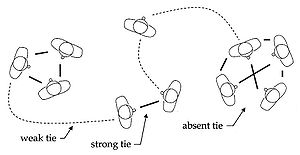The paper I wrote “Social networks of Wikipedia” got accepted for the 22nd ACM Conference on Hypertext and Hypermedia.If you are going to be as well in Eindhoven, on June 6-9, 2011, please let me know!
If you are interested, you can read the entire paper, the abstract is below. We also released the source code (Python) at sonetlab and released some network datasets extracted from User Talk pages (in GraphML format so you can easily import it in your tool, we like Gephi).

Network extracted from User Talk pages of Venetian Wikipedia visualized with Gephi.
Wikipedia, the free online encyclopedia anyone can edit, is a live social experiment: millions of individuals volunteer their knowledge and time to collective create it. It is hence interesting trying to understand how they do it. While most of the attention concentrated on article pages, a less known share of activities happen on user talk pages, Wikipedia pages where a message can be left for the specific user. This public conversations can be studied from a Social Network Analysis perspective in order to highlight the structure of the “talk” network. In this paper we focus on this preliminary extraction step by proposing different algorithms. We then empirically validate the differences in the networks they generate on the Venetian Wikipedia with the real network of conversations extracted manually by coding every message left on all user talk pages. The comparisons show that both the algorithms and the manual process contain inaccuracies that are intrinsic in the freedom and unpredictability of Wikipedia growth. Nevertheless, a precise description of the involved issues allows to make informed decisions and to base empirical findings on reproducible evidence. Our goal is to lay the foundation for a solid computational sociology of wikis. For this reason we release the scripts encoding our algorithms as open source and also some datasets extracted out of Wikipedia conversations, in order to let other researchers replicate and improve our initial effort.




![Reblog this post [with Zemanta]](https://i2.wp.com/img.zemanta.com/reblog_e.png?w=625)
